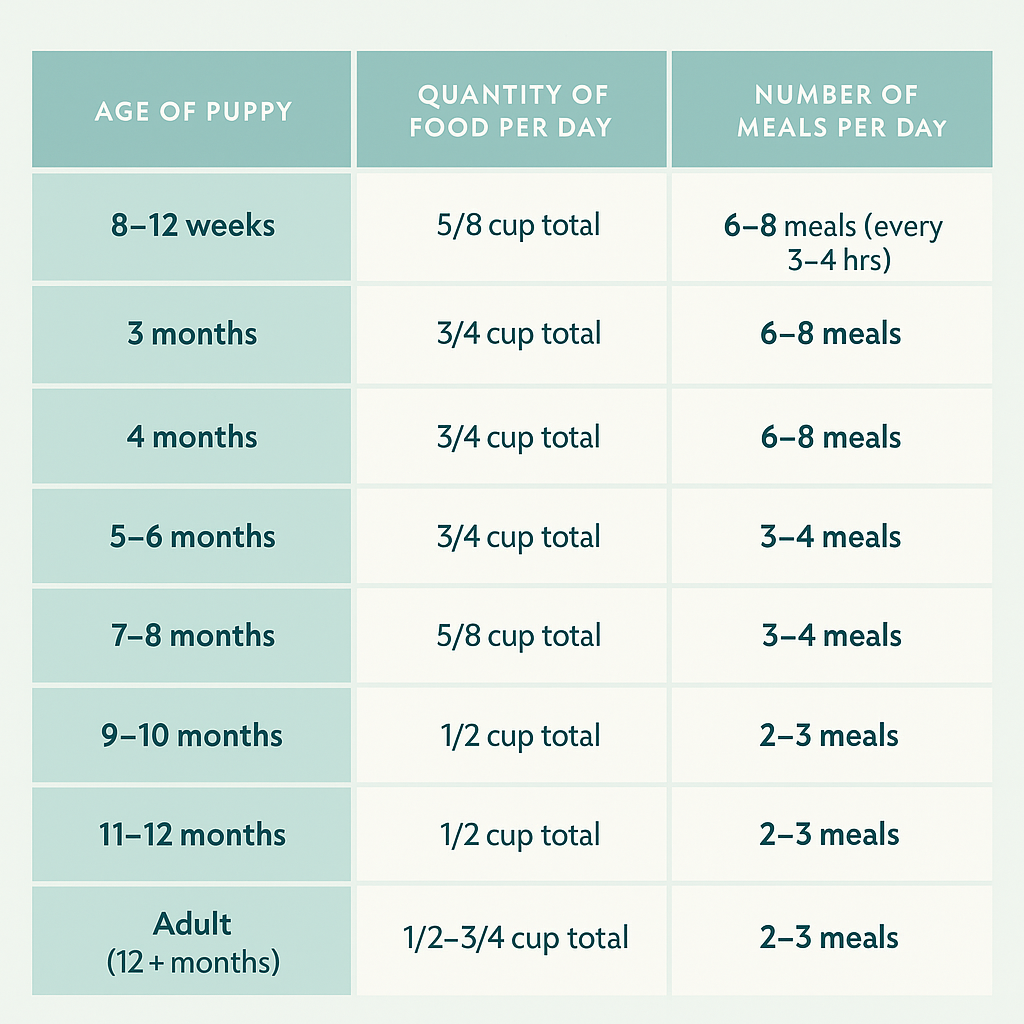Bringing Home a Teacup-Sized Puppy: What New Owners Should Know
By Ashley MR · 6 minute read
Last updated: August 29th, 2025

Bringing home a Teacup puppy is exciting, these tiny companions are full of personality, charm, and love. But because of their small size, they need special care, especially during their first weeks at home. This guide will help you prepare your home, set up a safe routine, and understand what to expect with your new Teacup.
Feeding Schedule to Prevent Hypoglycemia
One of the biggest risks for Teacup puppies is hypoglycemia (low blood sugar). Because of their tiny size and fast metabolism, they need to eat often to stay healthy and energized. Skipping meals or waiting too long between feedings can cause sudden weakness, wobbling, or even life-threatening episodes.
Always ensure meals are evenly spaced out to keep sugar levels consistent. This includes overnight feeding as required.
Here’s a sample feeding schedule for Teacup puppies:

Mawoo Pets Breeder Pro Tip: Always keep a puppy-safe glucose supplement (like Nutri-Cal) or sugar water on hand in case your Teacup shows signs of low blood sugar. Overnight feeding can usually stop by the 4-month mark, but always partner with your vet to decide when is best for your individual puppy's needs.
Important Note: Avoid Using Honey for Low Blood Sugar
While some resources suggest using honey to raise a puppy’s blood sugar, honey is not safe for Teacup puppies. Honey can contain spores of Clostridium botulinum, which may cause botulism in young dogs with immature immune systems. Even small amounts can be dangerous. This is also true with babies, so exercise caution with all the young ones in the family, furry and non-furry.
Instead, keep safer alternatives on hand:
Nutri-Cal or similar vet-approved glucose gel – specifically formulated for pets.
Puppy-safe sugar water (a small amount mixed with warm water) – a temporary emergency option until veterinary help is available.
⚠️ If your Teacup puppy ever shows signs of hypoglycemia (weakness, wobbling, tremors, extreme sleepiness, or collapse), administer one of the above safe glucose sources and contact your vet immediately.
Items to Prepare Before Bringing Your Teacup Home
Having everything ready before your puppy arrives will make the transition smoother and safer:
High-quality puppy food (vet-recommended for small breeds).
Shallow food and water bowls (lightweight and non-slip).
Nutri-Cal or sugar water (emergency supplement for low blood sugar).
Small crate or playpen (for safe resting and sleeping).
Soft, washable bedding (small enough to fit their crate).
Puppy pee pads like BrilliantPad or a litter tray (useful during house training).
Small-breed harness and leash (never use collars on tiny puppies).
Gentle grooming tools (soft brush, puppy shampoo).
Chew toys made for small dogs (to prevent choking hazards).
Pet-safe heating pad or blanket (to keep your puppy warm).
Puppy-Proofing Your Home for a Teacup
Because Teacups are so small, they face risks that larger dogs don’t. Think of them like a curious toddler who can slip into unexpected places.
Inside the Home:
Block off gaps under furniture or appliances where a puppy could crawl in.
Keep small objects, cords, and plastic bags out of reach — these are choking hazards.
Use baby gates to limit access to stairs, and ensure between the banister rungs are blocked so the puppy can't squeeze through the rungs.
Be mindful of where you walk — Teacups can easily get underfoot.
Avoid leaving your puppy on couches or beds unattended, as falls can cause serious injury.
Pay attention when opening closets and lower cupboards, as it is easy to accidentally lock them in without noticing their small size.
Outside the Home:
Inspect your yard and fence carefully before letting your Teacup outside. Even the tiniest holes in a fence can be an escape route.
Check for toxic plants, pesticides, or small objects in the grass.
Always supervise outdoor time — Teacups are vulnerable to predators like hawks or even larger neighborhood dogs.

Your Puppy is Home, Now What? A Week-by-Week Guide
Week 1: Settling In & First Vet Visit
✅ Prepare a quiet, safe space (crate or playpen).
✅ Stick to the frequent feeding schedule to prevent hypoglycemia.
✅ Begin supervised potty training (pee pads or litter tray).
✅ Keep activity calm — too much excitement can overwhelm a Teacup in transition.
✅ Book and attend your first veterinary appointment within 3 days of bringing your puppy home.
During this visit:
• Complete a full health exam
• Continue the vaccination and deworming schedule started by your breeder
• Microchip your puppy for permanent identification and safety
Week 2: Gentle Socialization & Safety Prep
✅ Purchase a GPS tracker for backup safety (small, lightweight, Teacup-appropriate).
✅ Continue gentle socialization with household members and different rooms.
✅ Introduce short sessions of harness wearing indoors. If your puppy is not fully vaccinated, do not take them outdoors for walks until this is completed to avoid deadly diseases like parvo and distemper.
✅ Continue positive handling (touching paws, ears, mouth) to prepare for grooming and vet visits.
Week 3: Training Foundations & Visibility Gear
✅ Teach name recognition and simple commands (sit, come).
✅ Continue crate training and practice short alone-time sessions.
✅ Start short car rides in a secure carrier. Carry your dog when outside until fully vaccinated.
✅ Introduce high-visibility puppy gear (reflective harness, vest, or leash). This makes your Teacup more noticeable to people, cars, and bikes during walks.
✅ Begin gentle grooming (soft brush, puppy shampoo).
✅ Confirm next vet visit for booster vaccines and check with your vet as to when you can begin outside training.
✅ Look into trainers in your area that have experience working with teacups and your specific breed of puppy so they can help prevent unwanted behaviors as your puppy matures.
Week 4: Routine & Expanding Confidence
✅ Stick to a regular feeding, potty, and sleep routine.
✅ Safely introduce household sounds (vacuum, TV, doorbell).
✅ Begin short outdoor walks if your vet has cleared vaccinations — always using high-visibility gear and a secure harness.
✅ Allow controlled socialization with one calm, fully vaccinated dog.
✅ Review progress with your vet at the next scheduled visit and plan the next phase of care.
✅ Ensure your Teacup has visible ID tags in addition to their microchip + GPS tracker. You may need to special order these as they may come too large for your puppy's neck.
Mawoo Pets Breeder Pro Tip: The first 72 hours are critical. That vet visit is where your Teacup’s long-term health plan begins: confirm their care schedule, microchip for safety, and continue breeder-started vaccines and deworming.
Final Thoughts
Teacup puppies bring big joy in a tiny package, but they do require extra care and attention. Frequent feeding, a safe and prepared home, and careful supervision are all key to helping your new puppy thrive. With the right setup and routine, your Teacup will adjust smoothly and quickly become the heart of your household.
Related articles
Related puppies for sale
Any questions? Get in touch!
We are here to support you every step of the way. Our concierge service is here daily to answer your questions!
Chat or speak with our team Mon-Sat 9a-9p ET.





























